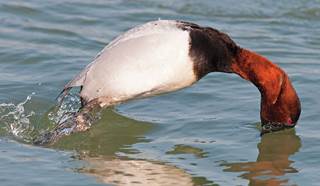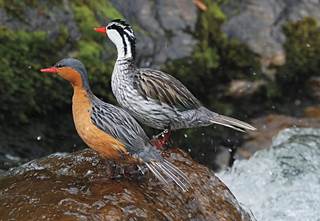Understanding Waterfowl: Masters of the Air and Water
Ducks and geese have many unique adaptations that allow them to thrive in these diverse environments
Ducks and geese have many unique adaptations that allow them to thrive in these diverse environments
By John M. Coluccy, PhD
Whether it's a squadron of wood ducks maneuvering through a mature bottomland hardwood forest, a flock of Canada geese whiffling into a cut cornfield, or a raft of canvasbacks diving for submerged aquatic plants on a windswept estuary, the amazing physical abilities of waterfowl have inspired humankind for centuries. Waterfowl are truly world-class athletes when it comes to flying, swimming, and diving. Let's examine some of the specialized traits that contribute to the birds' mastery of the skies and aquatic environments.
Wings and feathers are the most recognizable flight adaptations among waterfowl and other birds. Together, the wing and flight feathers form an airfoil, with rigid primary feathers providing thrust and uniquely shaped secondary feathers creating lift. The vanes of these feathers have tiny hooks, known as barbules, that "zip" the feathers together, giving them additional rigidity and strength. Soft feathers called coverts create a smooth surface to improve airflow over the wing. Contour feathers streamline the body.
Flight is the most energetically taxing activity that waterfowl undertake, consuming nearly 15 times more energy than resting. Consequently, birds possess many less-conspicuous adaptations to improve flying efficiency. The waterfowl skeleton is exceptionally light and strong, consisting of hollow bones that are fused together and reinforced in places to withstand stress and support the bird's large flight muscles. Generously supplied with oxygen-rich blood, these dense, red muscles are located near the bird's center of gravity, just below the wings, to provide balance.
To power their flight, waterfowl have a large heart, consisting of four chambers and two pumps, which operate in tandem. One pump supplies oxygen-rich blood from the lungs to the muscles while the other moves oxygen-depleted blood back to the lungs. The separation of oxygen-rich and oxygen-depleted blood is extremely efficient and well suited for the rigors of flying.
The respiratory tract of waterfowl is also ingeniously designed, consisting of the nares (nostrils), tracheal system, lungs, and air sacs. Inhaled air is cleansed and heated as it passes through the nares on its way to the respiratory tract. A breath of inhaled air first passes into the posterior air sacs and is forced into the lungs upon exhaling. When the next breath is inhaled into the posterior air sacs, the first breath is forced from the lungs into the anterior air sacs. The air from the first breath is then exhaled while the second breath moves into the lungs. With each breath, nearly all the air in the lungs is replaced, resulting in highly efficient gas exchange. This unique system provides continuous, unidirectional airflow, delivering large amounts of oxygen and removing body heat generated while flying.
Although waterfowl have developed many ways to streamline, lighten, and eliminate unnecessary structures, no corners have been cut in the nervous system. The birds possess proportionately large brains connected to keen eyes with ample processing centers that relay and coordinate visual information. Commands from the brain are transmitted quickly via short nerves to the muscles controlling the wings and tail, enabling the birds to react without hesitation while flying at high speed. This combination of acute vision, quick decision making, and high-speed nerve transmission allows a wood duck to dip and dive through the limbs of a forested wetland with relative ease.

Webbed feet, a specially designed respiratory system, and a "diving reflex" allow diving ducks to forage underwater.
Photo © DavidStimac.com
The legs and feet of waterfowl are the most obvious adaptations for aquatic life. Designed primarily for paddling, their exceptionally strong legs are set back on the body and their feet are large and webbed. While swimming, waterfowl push back and downward with their legs and feet to create forward thrust. Webbing between the toes expands on the downward stroke, creating greater surface area to push more water. On the upward stroke, the toes fold together to minimize resistance. These motions supply the lift and force needed to propel waterfowl efficiently through the water.
Diving ducks also use their webbed feet to dive and swim underwater while foraging. To avoid floating to the surface like a cork, a diving duck must paddle constantly to offset the buoyancy of its body. Dabbling ducks, geese, and swans use their webbed feet to tip up while foraging in shallow water. Webbed feet are also useful for walking in mud-they act like snowshoes to evenly distribute body weight and keep the bird from sinking.
Diving ducks need to carry large volumes of oxygen with them while they are underwater. As a result, the lungs and air sacs of these species carry a greater volume of oxygen than those of dabbling ducks. For example, the respiratory system of lesser scaup is estimated to account for 52 percent of their initial buoyancy.
Diving ducks have an unusually high tolerance for asphyxia (oxygen depletion). Oxygen consumption while underwater is greatly reduced by rationing available oxygen to sensitive tissues such as the central nervous system and sensory organs. The heart rate is reduced and blood flow to most other organs and skeletal muscles is curtailed during a dive. At these times, the organs and tissues rely on anaerobic metabolism. This "diving reflex," as it is known, is triggered when water touches special receptors in the nares.
From head-to-toe, waterfowl are uniquely adapted for life in the air and on the water. The next time you are out in the field and spot a flock of ducks or geese, take a moment to marvel at the amazing design that allows the birds to master the diverse environments in which they live.
Dr. John Coluccy is director of conservation planning in DU's Great Lakes/Atlantic Region.

Photo © G.A. Ceron
Weighing less than a pound on average, the torrent duck has managed to survive for nearly 1 million years by expertly diving for food in the high-altitude rivers of the Peruvian Andes. To survive in such an oxygen-poor environment, this unique species possesses extremely high concentrations of myoglobin, a protein that holds oxygen in muscle tissue. The torrent duck also has high levels of hemoglobin, the oxygen-carrying protein in red blood cells. These adaptations allow the birds to maximize the oxygen stored in their tissues and thrive in the rarefied air of the high Andes.
Ducks Unlimited uses cookies to enhance your browsing experience, optimize site functionality, analyze traffic, and deliver personalized advertising through third parties. By continuing to use this site, you agree to our use of cookies. View Privacy Policy